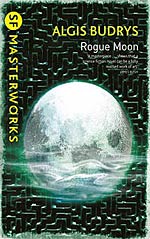
![]() charlesdee
charlesdee
7/31/2011
![]()
Since my return to science fiction I have read a novel that takes a billion years in the future, one set about 30,000 years in the past, and at least one placed in a future with which we have more or less caught up. And then there are those set comfortably out of range in say the 2300's, a time lapse that allows maximum leeway for the writers to toy with what might be possible developments of the technology they were living with as they wrote.
Rogue Moon, by Algis Burdrys, was written in 1959 and takes place in 1959. That makes it a special sort of period piece. I was only eight years old at the time, but the settings and much of the adult behavior Burdrys depicts reminds me of the more mature television and films I saw then. Rich people drive sporty cars and live in ultra-modern glass houses overlooking the ocean. Everyone drinks a lot. Scientists slave away long hours in the lab and have trouble "relating" to others. What sets Burdrys' 1959 apart from the real thing or any other version of it is the nature of the scientists' endeavors. They have perfected a "matter duplicator" capable of sending a man to the moon. This marvel is a joint project of the military and the private sector, and in one priceless, throwaway moment, a moment that probably did not strike Burdrys the way it struck me, Dr. Edward Hawks, the head of the project, tries to adjust the temperature in his office by fumbling with the recalcitrant knobs of his window unit. So the government can send men to the moon but won't fork out for central air.
Each man they send to the moon dies. They die in their effort to penetrate an alien-built labyrinth where one wrong turn means instant death. But each man adds some knowledge to the mapping of the labyrinth, and I guess it says something to the quality of the U.S. soldier that volunteers do not seem in short supply. Hawks has also perfected the process of storing a duplicate of the hapless volunteer, one that can be reconstituted after the real self dies on the moon. Unfortunately, those duplicates invariably go insane, having experienced their own deaths.
Enter one Al Barker, described on the back of the 1960 Gold Medal paperback edition as a "suicidal maniac whose loving mistress was Death." Like all good jacket copy, this has only a tangential relationship to the actual character. He is a one-legged, millionaire adventurer who loves to take chances. Vincent Connington, the odious personnel director of the company funding the moon project, thinks Barker is just the man to survive these missions, and he turns out to be right.
But wait, everything I'm writing implies that Rogue Moon has much more plot than it really does. What Burdrys gives us is a group of characters who all seem to loathe one another, and long, I mean really long conversations about scientific progress, life, and death. I suspect some of it was meant to be weightier than I was finding it. It reminded me at times of the dull parts of the old Outer Limits series, which as I child I thought given to too much talk and not enough monster -- an opinion reconfirmed by the dvd release of the series. But Burdry's finishes things off with an excellent set piece on the moon, and some final twists about the nature of the project that make for a satisfying last dozen pages or so. And by the way, the whole thing is really short.
I liked it. And I really liked the 1960 paperback with its spooky cover and the blurb line "A GREAT SCIENCE FICTION NOVEL!" The blurb is left unattributed since it obviously originates from the publisher and not some outside source.
http://www.potatoweather.blogspot.com